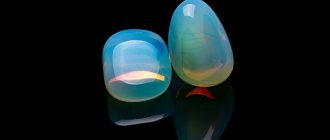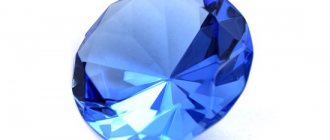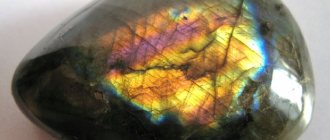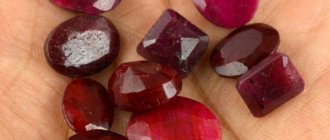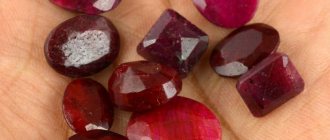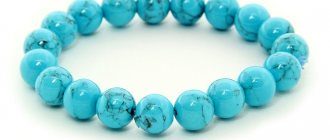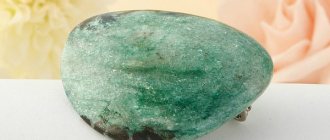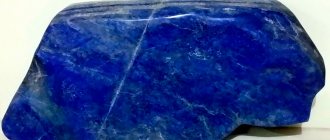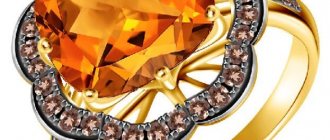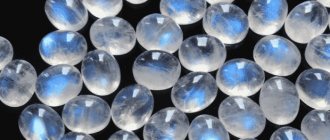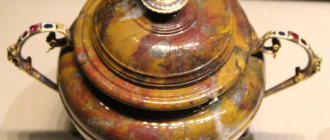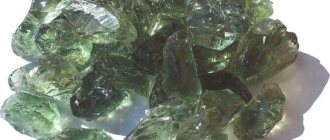| Category | Plutonic rocks |
| Title in English | Labradorite |
| Formula | SiO2 45-52% |
| Group | Labradorite group |
| Color | Colorless, White, Gray, Reddish, Bluish, Greenish, Black, Brown, Blue |
| Stroke color | Colorless |
| Shine | Glass |
| Transparency | Transparent, Semi-transparent |
| singonia | Triclinic |
| Hardness | 6 |
| Cleavage | Perfect |
| Density, g/cm³ | 2,68 — 2,74 |
| Kink | Conchoidal, Uneven |
| origin of name | The name of this rock was invented by the German geologist Ferdinand Senft. Since labradorite is an accumulation of the silicate mineral labradorite, the scientist could only draw an analogy and form a new name. To avoid confusion, a proposal was made to rename the stone to labradite, but this idea did not receive widespread support. |
Labradorite is an igneous plutonic basic normal-alkaline rock, a type of anorthosite and belongs to the gabbroid family. It contains the mineral labradorite, as well as admixtures of pyroxene and other ore minerals. The name of the breed is associated with the Labrador Peninsula in North America. Polished labradorite has a blue, red or yellow iridescence. The mineral is widely used as an ornamental and facing stone.
Historical reference
Labradorite is a stone that is associated with the mysterious northern people of the Hyperboreans, the ancestors of the peoples of Europe. There were legends in Ancient Greece that it was they who, in time immemorial, discovered the magical properties of the gem. At that time, the belief arose that only a worthy person would be helped by a crystal. Anyone whose motives and thoughts are base will not be able to use it for their own purposes.
Myths say that Labradorite is a moonstone. The spells of an unknown witch turned the rays of the night light into crystals endowed with magical powers. It is not known who exactly composed this legend - the Greeks or the priests of Babylon.
In Mesopotamia, Labradorite was considered the eye of God. Peering into its rainbow depths, the priests recited prayers and spells. In Babylonian treatises you can read that a gem recognizes only one owner, and in the wrong hands it loses its power. Therefore, it was kept in a bag near the heart and buried along with the bearer.
Hindus discovered another magical property of the Labradorite stone - the ability to cherish marital love. The husband and wife were supposed to have one copy of the mineral. At the same time, blue and greenish specimens were considered male, and golden ones were considered female.
In medieval Europe, it was believed that Labradorite was a stone sent to people from heaven. Masons used the gem in the construction of cathedrals and monasteries as a powerful energy accumulator. It was also credited with incredible healing powers: doctors prescribed the crystal to their patients.
For Labradorite, as for any other famous gem, there are many historical names:
- black moonstone;
- moon opal;
- fish eye;
- peacock stone.
However, it has nothing in common with opals. As with the similarly named labradorite, a rock known as a facing material.
At the end of the 18th century, interest in Labradorite, which had died down during the Renaissance, flared up again. This was due to the discoveries of huge deposits of gemstones in Russia and Canada. Many beautiful stone samples entered the European market. It was a rare fashionista in those years who could not boast of an exclusive piece of moonstone jewelry.
general information
Labradorite is a unique gem. Its rainbow tints, similar to the Northern Lights, captivate the eye. Occultists claim that it has strong magical properties that have no analogues. The stone has also found its use in lithotherapy, a branch of alternative medicine that heals ailments with the help of minerals. Due to its natural beauty, it was used to make jewelry.
Colors and varieties of mineral
Depending on the crystallographic and optical properties, the following varieties of Labradorite are distinguished:
- Spectrolite is a labradorite that shines with all the colors of the rainbow. Spectrolites are found in Finland, where they were discovered in 1940 in Ylämaa during the construction of the Salpa Line (fortification line); The development of spectrolites in Ylämaa began after the Second World War.
Spectrolite
- Black moonstone is labradorite with blue and blue iridescence (it is precisely this labradorite that is used to decorate the central staircase of the RSL - “Leninka”, rounded blue spots, shimmering with mother-of-pearl, become clearly visible in appropriate lighting, natural sunlight falling from the windows). Simply “moonstone” is usually called adularia - a mineral with light blue iridescence).
Black labradorite moonstone
- Sunstone is a labradorite with golden iridescence, mined in Oregon (USA).
Sunstone labradorite
What is labradorite?
The formation of labradorite occurred at a time when the Earth was shaken by numerous volcanic eruptions. Temperature and pressure changes created ideal conditions for the appearance of a stunningly beautiful mineral.
Blue, green and golden tints flash against the dark background inherent in the main color of the stone.
Most crystals are colored in smoky shades with a rainbow tint. Thanks to its bizarre coloring, the stone acquired other names: “Hyperborean rainbow” and “peacock eye”.
Varieties and their colors
The classification of labradorite is based on several criteria: origin, composition, optical properties and color. The names of the species reflect the prevailing colors and tints of color:
- Black moonstone with iridescence effect. Place of production: deposits of Madagascar.
- Spectrolite . The main color is blue with rainbow tints. Mined in Finland.
- Bulls-eye . Has the effect of asterism. White highlights appear against the brown background of the main color of the stone.
- Solar labradorite is mined in the USA. Golden tone with iridescence.
- Aventurine labradorite contains magnetite and copper, which create its golden color. The color contains reddish-copper tones. A special difference is the shimmering shine.
- Lynx eye is green. Has the effect of asterism.
- Blue tavusite . A very beautiful species, obtained in Norway. The color resembles that of a peacock feather, even the green “eye” is present.
Physical and chemical properties
Labradorite is characterized by bright rainbow tints (glares), called iridescence (or labradorization, or labradorescence). Most often these tints have blue and cyan shades, but can be green, yellow and red. This effect is associated with the interference of light in thin plates of different compositions that make up the mineral.
It crumbles when squeezed, easily splits when hit. Melting. Dissolves in acids.
| Property | Description |
| Formula | 30—50% NaAlSi3O8+50—70% CaAl2Si2O8 |
| Impurities | Fe, K, Mg |
| Hardness | 6-6,5 |
| Density | 2.69—2.70 g/cm³ |
| Refractive index | 1,560—1,568 |
| singonia | Triclinic. |
| Kink | Uneven, stepped and fragile. |
| Cleavage | Perfect. |
| Shine | Glassy to metallic. |
| Transparency | Opaque. |
| Color | Smoky gray, dark gray to almost black with a bright play of colors. |
Form of labradorite occurrence in nature
The appearance of crystals . Large lamellar grains up to 8-10 cm, granular masses, porphyroblasts, crystals. Well-formed crystals are rare, such as in the ashes of Monte Rosa on Mount Etna, Sicily.
Labradorite twins Albite and Carlsbad twins are typical. In marbles Center. In the Alps, a crystallographically regular germination of labradorite An66 and andesine An34 was observed. Both plagioclases appear to grow simultaneously, with andesine nuclei appearing on the (110), (110), (100) and (130) faces of labradorite.
Aggregates. Grainy, dense.
The magical properties of Labradorite
Product with labradorite stone
The magical power of crystal has been known for a long time. Charms with this mineral were worn in rings and cabochons to attract strength of spirit and will. The peculiarity of labradorite is that the nugget is able to influence the fate of its owner and reveal his energy potential.
Thanks to the fire element, the gem is endowed with great supernatural magical power. The aura of the crystal and its energy are quite strong, this helps to open true knowledge even to those who have recently begun to study magic.
Labradorite has a multifaceted effect:
- promotes the discovery of the gift of clairvoyance;
- enhances energetic strength;
- awakens talents;
- protects the owner and his house from the evil eye;
- helps to harmonize relationships between family members;
- increases love;
- helps to get out of depression;
- promotes constant optimism.
The stone especially favors creative individuals: artists, composers, writers. The crystal helps them overcome obstacles, unleash their creative potential, climb the career ladder, bypassing envious people and obstacles.
Magicians use Labradorite in their practice:
- as a guide to the other world in order to establish contact with the souls of deceased relatives;
- to penetrate people's subconscious in order to read their innermost thoughts, see the past and tell about the future.
However, there are some restrictions on the use of stone. This applies to young people under twenty-seven years of age. It is necessary to take the talisman with you only in serious cases:
- for business meetings;
- for a deal;
- when concluding an agreement;
- for negotiations.
Labrador is an excellent assistant in many matters, however, sometimes its power should not be abused.
https://www.youtube.com/watch?v=i-5LWdIf8Bw: If we briefly describe their difference, it looks like this: labradorite is a mineral. And labradorite is an igneous rock, it consists almost entirely of plagioclase (a labradorite mineral, but not 100%). We must remember that a mineral and a rock are not the same thing. These are different hierarchical levels of existence of geological matter. The mineral got its name from the Labrador Peninsula in North America, where it was discovered in 1770. Other names for the mineral and its varieties: black moonstone, bull's eye, spectrolite, caryatite.
Labradorite is one of the varieties of tulle spar. The color of Labradors is dark gray, greenish gray; it serves as a good background for the sparkling highlights of green, yellow or red, blue that run across it; when a stone is turned from side to side. Gloss - matte, glassy. The color of the Labrador itself is unattractive: from gray to almost black, mourning. However, the sparkling flashes playing on its surface give it the appearance of precious opal. Hardness - 6.0 - 6.5; density - 2.7 g/cm3. Main deposits. There are reports of very beautiful Labradors being found in Finland. Less bright Labradors are found in Germany, Greenland, India, Tibet and Ukraine. In Australia, there are gem-quality Labradors that can be cut. Medicinal properties In folk medicine, there is an opinion that labradorite contributes to the overall strengthening of the body. Some healers believe that this mineral relieves pain in diseases of the spine and joints. Lithotherapists believe that Labradorite helps with infertility and impotence, some diseases of the genitourinary system and prostate gland. Pendants and rings help improve mood, alleviate the effects of stressful situations, improve sleep and help with insomnia. It helps remove stones from the kidneys and generally improves the functioning of all organs. Its impact most affects the emotional and mental state, through the improvement of which the Labrador begins its specific therapeutic work. Rings (which should be worn on the middle finger) and pendants with Labradorite can even help a drug addict get rid of a painful addiction - in addition, they can easily relieve nervous stress in their owner, calm them down during feverish excitement, lift them out of depression and restore the body after nervous exhaustion. A figurine or a piece of stone, located next to the head of the bed, will relieve obsessive nightmares and cure insomnia, normalizing the body’s “natural clock”. Labradorite affects the solar plexus chakra. Magical properties The magical power of Labradorite has not been fully revealed - however, it is reliably known that it, like no other, enhances foresight and the ability to mystical awareness of the world, helps to develop extrasensory abilities and has long been considered a talisman of healers and sorcerers. Experts believe that the Labrador retriever awakens hidden talents in a person and helps develop them, bestows bright dreams and forces its owner to try to “embrace the immensity”, to accomplish what previously seemed unattainable - this is exactly the talisman with which you will make the impossible possible. This is probably why the stone is recommended for mature people who are over 30 years old. The mineral can push younger people into adventures, which will lead to disastrous consequences for their future. Labrador is considered an amulet of creative people - writers, poets, musicians, artists; he brings them inspiration, the ability to “catch the wave,” and at the same time fame, recognition and patronage of patrons. The stone becomes very attached to its owner and protects him from all sorts of unpleasant situations and negative people. It is recommended as a guardian of peace and well-being in the home - but the Labradorite figurine or crystal should be kept in plain sight, and in no case should it be placed under the threshold, as some sources advise; When a gem “sees” the situation every day, it actively processes any negative energy into positive vibes.
This mineral draws its power from the Moon, so it should be activated by placing it on the windowsill every full moon. Gem experts distinguish Labradors “by gender”: lighter ones with a golden-blue tint are considered male, dark ones with a brownish-green tint are considered female. It is best to purchase a “family couple” of minerals - they will not only help you run your household competently and efficiently, but will also protect your family hearth and teach you to be more careful about your “other half.” It should be remembered that Labradorite cannot be carried on you all the time, and under no circumstances let strangers touch your talisman - aimless touches destroy the friendly power of the stone. Astrologers recommend it to all zodiac signs without exception, but it is especially useful for Leos, Scorpios, Aries and Virgos. Labradorite is energetically connected to the heart, sex and throat chakras. Talismans and amulets Labradorite is a wonderful amulet for the house and all households; it should be kept on the surface so that it can see people, the house itself can be visible. Wrong advice is to place a stone under the threshold of the house. Talisman of practicing magicians and all high-level “wizards”. Labrador hates those who strive for evil, but will not interfere with them, however, sooner or later, it will lead such people to a very sad end. The stone becomes very attached to the owner, loves him and strives to help in all, especially very unpleasant, situations, so Labrador is an excellent amulet for people who have to take a lot of risks. He is an irreplaceable talisman of people who are searching, but who stand firmly on their feet and always analyze matters and situations, and are able to make at least minimal forecasts. Labrador will connect its owner with the past, help to see the connection between the present and the past, and draw the right conclusions. The stone will also contribute to foresight, but only for those who are naturally inclined to this activity, who have been given a certain gift and this gift is not spent immorally. Labradorite contributes to a person striving to mystically comprehend the world and activities in it. Interesting - from history, the Hyperboreans, according to one of the legends, were the first to show people the beauty of an amazing stone, shimmering with all the colors of the rainbow. Labradorite has become widely known in Europe since 1770, when it was found on the island of Labrador in northern Canada - soon Parisian and London fashionistas were wearing rings, earrings and brooches with the “peacock stone”. And during the construction of the Hermitage in 1781, several blocks with labradorite eyes were suddenly discovered in the vicinity of St. Petersburg, which provoked a surge in the popularity of the gem in Russia - tabletops made of labradorite appeared in the royal residences, the St. Petersburg nobility fell in love with golden snuff boxes with rainbow stones, and even ball gowns to match the jewelry were made from iridescent “tausin silk” (in the old Russian dialect the word “tausin” meant “peacock”). Application In the middle of the 19th century, a rich deposit of labradorite was found in Ukraine, and since then the stone has been actively used in the cladding of interiors and exteriors: for example, it was used in the decoration of the Mausoleum of V. I. Lenin, some metro stations in Moscow and many monumental buildings and architectural monuments. Today, labradorite is one of the most popular ornamental stones, and it is used both for inserts into jewelry - rings, bracelets, earrings, necklaces, cufflinks and much more - and for creating interior sculptures and small decorative items. Labradorite is still mined there - the deposits are still not exhausted in Burma, and in Ukraine, and on the island. Labrador is in Canada, but its availability has once again become a thing of the past - today only a person whose fortune is truly royal in wealth can afford a large statue, and especially the façade cladding made of spectrolite. The natural stone labradorite is a granular crystalline rock. Color of labradorite (photo): in nature there are various color shades of this stone, but dark gray, light gray, and bright blue shades are more common. Initially, deposits of this mineral were discovered on the Labrador Peninsula, which is why this stone is called labradorite. It should be noted that after jewelry processing, the stone acquires an exceptionally beautiful appearance. Highly skilled craftsmen are able to make a worthwhile work of art from this stone. The stone has an interesting internal structure, which appears after jewelry processing. Each stone is unique in its own way and has a unique pattern, color and internal configuration. Labradorite and zodiac signs Suitable for Taurus, Leo and Scorpio. Labradorite has magical properties Since ancient times, the mineral has been credited with special properties that cannot be found in any other natural mineral. One of these properties is the magical property. It is also known from ancient writings that labradorite is capable of exerting a magical effect on the environment. It is noteworthy that labradorite acquires properties from its owner and can have both positive properties and negative effects. If the owner wishes harm to someone and at that moment comes into contact with the stone, then it adapts to the energy of the owner and makes his wishes come true. In a similar way, labradorite also acquires positive properties and is capable of bringing a lot of benefits to others and to the owner of the stone himself, if he wishes good things to others with all his soul. In order for the effect to be maximum, after energy replenishment from the owner, the stone must fall into the hands of the person whom you want to influence in one way or another. As a last resort, the stone should be placed next to this person, for example it can be hidden in the pillow on which he sleeps, or sewn into the mattress. According to eyewitnesses, the effect of the stone is simply amazing. The magical properties of labradorite are used as a love spell. So if a girl is in love with a man and places the labradorite stone that belongs to her next to him, then after a while her dream of mutual love becomes a reality. It is known that labradorite is a stone that contributes to the development of the gift of foresight in a person. The effect is especially noticeable if a person has natural abilities for foresight. It turns out that the stone is a kind of amplifier of a person’s foresight abilities, which are given to him by nature. These properties of the stone were widely used earlier and are now used by sorcerers and magicians. By interacting with the stone and using labradorite’s magical properties, they are able to predict fate and even influence events that are destined to happen in the future. Magicians, sorcerers and healers use the healing properties of the stone. It has long been known that labradorite can have a positive effect on the course of many chronic diseases, and it can simply heal many of them. Labradorite and naturopathy Labradorite is widely used to treat eye diseases; the mineral has a positive effect on the course of heart and vascular diseases, and helps with memory loss. Ancient healers used labradorite to treat mental disorders, because previously there were no medicines that would treat the human psyche. Therefore, labradorite was widely used to relieve nervous tension and combat insomnia. Currently, this mineral is used to treat nervous asthenia, as well as to treat depressive disorders. According to experts, labradorite is very effective for infertility, and it treats both female and male infertility. In addition, this mineral stimulates male potency; in urology it is used to treat prostatitis. Labradorite helps with diseases of the musculoskeletal system, as it perfectly cures acute inflammation of the joints, and also alleviates the course of arthrosis and even rheumatoid arthritis. Experts say that labradorite accelerates the healing of fractures, especially this property of the stone is in demand in the treatment of fractures in the elderly. How to distinguish Labradorite and what Labradorite looks like Natural Labradorite in a silver setting An amazing stone due to the variety of colors, there are no minerals in the world that can repeat the pattern! An excellent combination of nondescript and bright. Natural stones are defined by their viewing angle: from one angle they are gray, dark or even black, but turn it and you can see the whole palette of variety in color. The name of the stone comes from the place of its first discovery, the Labrador Peninsula (Canada). Many people confuse it with another name: Labradorite, but this is a completely different mineral that does not belong to the family of moonstones. An interesting fact about Labradorite: Labradorite contains Ilmenite inclusions - microscopic inclusions of the mineral that are also found in lunar soil. Labradorite has several varieties: with blue and light blue iridescence, it is a black moonstone. With yellow, pale yellow, orange iridescence - this is a sunny Labradorite. With the iridescence of all the colors of the rainbow, this is labradorite spectrolite (it is more expensive and is valued more than all other varieties).
The photo shows the collection of Eva Koshkina. Masculine and feminine gender of Labradorite Labradorite is divided into masculine and feminine gender, namely: blue and blue is a masculine stone, with a greenish tint it is feminine. In order for the stones to interact with each other and combine their power, it is recommended to wear them together, female and male minerals. In this combination, they help well in love, strengthening marriage and any love relationship. An excellent assistant in magic, the Labrador's ability to help is limitless, if you admire it and look at it for a long time, it is able to calm the nervous system, a wonderful home amulet in the form of a figurine. Rules for wearing a Labrador, energy charging a Labrador There is a rule for him! He should always be in sight! It cannot be hidden or kept in the dark! Like all moonstones, it loves to be recharged with the help of moonlight; if possible, try to leave your Labradors under the moonlight from time to time - the stone will be recharged, plus it will only be grateful to you! A stone can take offense if it is treated carelessly, so your constant connection with it is very important. The misconception is that men cannot wear rings and pendants, but they very well can; they are excellent assistants in negotiations and important meetings.
Amulets, amulets, talismans
Pendant on a chain Labradorite
Amulets enhance magical visions and abilities, and activate hidden talents. Mediums use stone products to create channels with the other world. Talisman or amulet made of mineral:
- protects against interference in the aura of alien entities;
- protects the house from “black” magicians;
- activates extrasensory perception;
- helps make dreams come true;
- reduces stress;
- attracts harmony and luck;
- smoothes out bad memories.
The talisman will calm an anxious person and eliminate negative influences. The stone takes power from the owner, giving the strength to act, sending prophetic dreams.
Amulets and charms made from gemstones look sophisticated and allow you to demonstrate the taste of the owner. They choose according to the horoscope, the advice of magicians or astrologers.
Why are they confused?
The confusion in terms occurred for three reasons:
- in some languages, labradorite is called labradorite, so errors occur during translation;
- mining occurs predominantly in the same regions;
- More than 90% of the rock is still pure mineral. Externally the stones are similar. Therefore, people far from this area often do not see the difference.
It is worth noting that professionals (jewelers, gemologists) can easily distinguish natural Labradorite from fakes.
Medicinal properties
Labradorite
Labradorite contains a number of medicinal properties that affect not only individual problem areas, but the entire body as a whole. The stone is used by healers in cases of:
- hypertension;
- eye diseases;
- infectious and viral diseases;
- disorders of the nervous system (psychosis, stress, insomnia or anxious dreams, depressive states);
- problems with bones, muscles or joints.
In addition, lithotherapists note a positive result after a massage using any type of stone - joints become more mobile, muscle and other types of pain in the musculoskeletal system disappear, salt deposition slows down.
Among the capabilities of Labradorite, doctors note a general strengthening effect on the body. The stone ensures uninterrupted functioning of the immune system, normalizes metabolism, improves memory, and increases brain performance. This makes the mineral indispensable for people engaged in mental work.
The healing powers of the gem do not end there. Labrador is an assistant for women and men when there is a problem:
- infertility;
- impotence;
- diseases of the genitourinary system;
- kidney diseases;
- drug or alcohol addiction.
Labrador will help a woman not only conceive, but also bear a healthy child. Experts are also inclined to believe that the stone can prevent the development of cancer.
The unimaginable play of light makes the mineral not only visually attractive. Spectral changes on the surface of a mineral directly affect a person’s emotional state. Constant interaction with your Labrador improves your mood, helping you enjoy life without stress, insomnia or nightmares.
Birth of a stone
When mining labradorite, one is struck by the “eyes” that shimmer blue, green, even crimson with a golden glow. This is the most valuable thing in the stone. This is what attracts mystics so much to the mineral.
Labradorite is an igneous rock. The temperature and plasticity of magma are very high. Atoms of aluminum, oxygen and silicon are grouped, forming crystal nuclei with an openwork frame. Then they are joined by potassium, strontium, rubidium, iron...
The temperature cools down, and the outer layer of the “lump” also cools down - but inside it breaks up into the thinnest plates. It turns out something like puff pastry. Many, many layers. The light is reflected several times, returning to the viewer in a rainbow inflorescence. This play of colors was even called iridescence (named after the goddess of the rainbow, Iris).
Areas of application
Since the end of the 18th century, it has been a valuable jewelry and ornamental stone. It is also used as a facing stone (for example, used in the decoration of the Lenin Mausoleum).
Iridescence is clearly visible on a polished surface, which is why spectrolites are used to make costume jewelry and handicrafts. It is used to create bracelets, earrings, and pendants. Labradors are often processed in the form of cabochons. Some varieties are used to make faceted inserts. Due to its relative softness, the stone is wonderful for creating figurines or small figurines.
Madagascar labradorites with a strong blue tint are also prized. Australian colorless, yellowish-brown transparent labradorites are successfully cut.
Terms of use
Labradorite is fragile, so it is strengthened from cracking.
But you need to take care of it carefully:
- The box and products are protected from sudden temperature fluctuations.
- Before homework, the bracelet, ring, and ring with labradorite are removed.
- Dirt is removed with warm water and a soft cloth, without the use of active household chemicals.
Earrings, a brooch or a pendant with a stone are especially impressive in the sun, but in hot weather for a long time or on the beach it is better not to wear them.
Stone products and decorations
Labradorite in decoration
Labradorite is not considered the most popular mineral. But its aesthetics and magical properties are worth wearing.
Gems look very impressive due to their optical properties. They go perfectly with evening dresses and look good as cufflinks on men's suits. Suitable for business meetings.
Jewelry will highlight interesting tones in clothing, such as deep purple or burgundy.
The most common types of jewelry made from Labradorite are:
- pendants;
- beads;
- earrings;
- bracelets;
- brooches;
- rings;
- bracelets.
Uncut stones are cheap. The price of processing, design work and material for the frame is included in the jewelry item. A cabochon weighing up to 1 carat costs up to $5, a bracelet costs $35, and uncut beads cost $20.
Story
— Advertising —
The unusual iridescent rock on the Labrador Peninsula was once discovered by the Indians, but it did not become popular among them. Archaeologists also found fragments of labradorite in Viking settlements near Labrador and Newfoundland.
For a long time, this rock was forgotten and returned to mineralogy only at the end of the 18th century, when the German scientist Abraham Gottlieb Werner systematized the previously accumulated knowledge, described labradorite and gave it a name after the Canadian deposit. After this, the rock was still considered rare and the search for its deposits continued in other parts of our planet.
They were successful and today labradorite is mined in Madagascar and Ukraine, Finland and Yakutia, the USA and Mexico.
Later, scientists found out that people used labradorite in construction, but did not identify it as an independent rock. And now materials are made from it for cladding, interior decoration, and decorative covering of furniture. Unusual and interesting designs are also used in jewelry.
How to recognize a fake
Ring with a Labradorite stone
Fake Labradorite comes on sale quite often. For example, some sellers sell specimens of unknown origin, passing them off as moonstones. In fact, it can be anything, even a piece of glass, even rock crystal.
Fortunately for buyers, it is impossible to create a counterfeit that is completely identical to the original in all properties. Therefore, a thorough check will always help bring fraudsters to clean water. You need to be especially careful if you plan to practice stone healing or magic, and that is why you are buying a Labradorite.
There are several ways to check whether the gem in front of you is real or a cheap counterfeit.
- Twist the Labradorite in the light, peering into the depths of the stone. It will shimmer in different colors and shades. It is very difficult to counterfeit iridescence, so scammers never do this. The copy in which the shades play is genuine.
- Press the stone against your body. Minerals have low thermal conductivity and will not heat up from your heat. Plastic or glass will warm up instantly.
- Carefully study the product data sheet. If it is not there at all, it is better to refuse the purchase. On fakes, they sometimes put the name of the imitation stone in quotation marks, or write something like “synthetic” in small, barely noticeable letters. This is a way to get rid of accusations of fraud on the part of the inspection authorities - formally, they honestly wrote to you that this is a fake.
Spectrolite and labradorite: meaning
The meanings behind spectrolite and labradorite are rooted in their iridescence. Their dark surface with shining rays of color mainly symbolizes protection and transformation.
Labradorite is a stone of protection and wisdom. Primarily associated with the mind, many use labradorite to increase their level of self-awareness or reduce their self-doubt. This stone is believed to protect against negativity, both internal and external.
Spectrolite is endowed with more mystical properties. The stone symbolizes healing and transformation, but these do not actually come from the stone itself. It is believed that spectrolite helps to find answers within oneself. One way to do this is to make you feel more confident in your intelligence by inspiring original ideas or solutions. Another way is to identify any existing psychic powers, such as clairvoyance or prophetic dreams.
How to care for stone
Labrador is a rather fragile gem; it is afraid of the effects of negative environmental factors. To preserve the beauty of the mineral, you need to handle it carefully:
- Avoid mechanical damage: do not drop or hit other hard objects.
- Store in a separate bag or special case away from other jewelry.
- Avoid exposure to household chemicals and direct sunlight.
- Try to stay away from places with temperature changes.
- Wash in running water or soapy water using a soft brush.
What stones does it go with?
Ring made of labradorite with blue iridescence.
Labradorite is energetically combined with such stones as:
- jasper;
- malachite;
- turquoise;
- morion;
- lapis lazuli:
- jade;
- chalcedony.
But the energy of Labrador is completely incompatible:
- with pomegranate;
- topaz;
- carnelian;
- emerald;
- onyx.
Name compatibility
A strong and mysterious Labrador is the patron of all women whose name is Yana. Intellectual by nature, Yana will be able to emphasize mental abilities, receiving wisdom from the stone on an intuitive level. The talisman will help her lower the veil of illusions, revealing the true face of those around her.
The fact that a stone belongs to only one name does not mean that others cannot wear it. The main requirement of a Labrador is character. The stone will destroy a wicked person, leading him to a dead end in life.
Care and price
You need to care for the Labradorite stone as follows:
- Polish regularly with a soft, clean cloth or a special brush to keep it shiny.
- When processing, use only water. The use of detergents is prohibited - because they contain acids and alkalis, which can harm the stone.
- stored in a dry place.
- Labradorite tolerates high and low temperatures well, so there are no special recommendations regarding temperature conditions (although this does not mean that the stone can be stored in the cold or heated in an oven).
Labrador is not too expensive. A small pebble will cost only 5-10 dollars. The price of a good piece of jewelry for a woman will be about 50-60 dollars.
The average price of a beautiful Labradorite figurine will be about $100. Also, you need to understand that the markup in most stores is very large, so Labrador can cost even more.
Who is the Labrador Retriever suitable for?
Beads made of Labradorite stone
The gem is whimsical and picky about its new owners. He chooses his person according to the stars under which he was born. Each sign is affected differently:
- Aries should not wear gems often. They will enhance the sign’s emotionality, impulsiveness, and confidence. But with constant wear, its negative qualities will increase - hot temper, irritability.
- Talismans will help Taurus find happiness and fill their lives with bright and pleasant impressions. With them, Taurus will succeed in their career.
- Labrador will allow Gemini to find balance, a balance between negative and positive character traits. Amulets will add healthy egoism to responsible, altruistic Gemini.
- It will give Cancers confidence and relieve them of excessive sensitivity and emotionality. Will help you become more friendly and open.
- Leos will become calmer. Amulets will add stability and harmony to their lives.
- Virgos will reveal their creative potential and find the inspiration they are looking for. They will become more charismatic and more interesting to others.
- Libra will not feel any effects from labradorite. He is absolutely neutral towards them.
- It is better for Scorpios to refrain from purchasing talismans with Labrador Retriever. They can strengthen their negative qualities and lead them astray.
- Sagittarians, more than others, are recommended to have an amulet with them. With him, Sagittarius are able to achieve a lot in every area of life.
- Capricorns will be able to moderate their ambitions and desires and take control of the situation. Stones will help them make the right decision in any matter.
- The Aquarius talisman stabilizes emotionally. Will give confidence and calm. It will help keep your emotions under control if necessary.
- The gem will help Pisces develop extrasensory abilities. With the amulet, Pisces will find new joys and will be able to enjoy ordinary but pleasant little things.
Interesting Facts
- A labradorite was found in Russia whose configuration resembles the profile of Louis XIV.
- The Tithe Church in Kyiv, decorated with Labradorite plates, amazes the imagination. History is silent about where so many cut stones were found in the 10th century.
- An Indian woman's wealth was judged by the presence of a bracelet made of sparkling minerals.
- W. Collins dedicated the book “Moonstone” to the gem, describing the changes in the fate of people who discovered inner talents.
- Lithotherapists believe that Labradorite can somehow accumulate the energy of the Moon. Therefore, during the full moon, it must be placed in an open place to recharge.
- Since ancient times, it has been customary to take a fish-eye ring with you on a trip for a safe return home.
- It is believed that Labrador owners can sometimes dream about things.
Place of Birth
Deposits of labradorite are numerous and scattered throughout almost the entire territory of the Earth. It is mined in Europe in the mines of Norway, Finland and Germany. It is also found in Australia.
The United States boasts decent reserves of the mineral, but Madagascar has little of it. If we talk about the beauty of the stone, the brightest specimens are found in deposits in India, Tibet, Mongolia, Burma and Sri Lanka .
In Russia, “peacock eye” is mined in some areas of Buryatia, Krasnoyarsk and Khabarovsk. Extensive deposits of the mysterious mineral, found on the territory of Ukraine along the banks of the Irsha River, were discovered in the 19th century. They devalued labradorite and relegated it to ornamental status.
